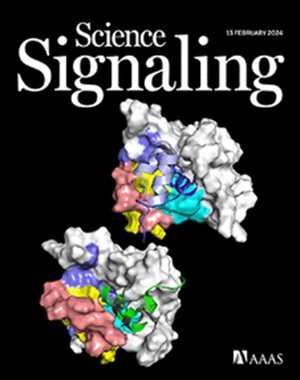Loss of STIM2, but not of STIM1, drives colorectal cancer metastasis through metabolic reprogramming and the ATF4 ER stress pathway
IF 6.6
1区 生物学
Q1 BIOCHEMISTRY & MOLECULAR BIOLOGY
引用次数: 0
Abstract
The large amounts of calcium (Ca2+) stored in the endoplasmic reticulum (ER) and the controlled release of this Ca2+ store into the cytosol regulate many cellular functions, and altered ER Ca2+ homeostasis induces ER stress. Stromal-interacting molecules 1 and 2 (STIM1/2) are homologous ER-resident Ca2+ sensors that synergistically activate cytosolic Ca2+ influx through Orai channels to promote Ca2+-dependent changes in gene expression and ER Ca2+ refilling. Here, we demonstrated that reduced abundance of STIM2, but not that of STIM1, was associated with poor prognosis in colorectal cancer (CRC). STIM2-deficient CRC cells showed enhanced ER Ca2+ content in a manner dependent on the ER Ca2+ pump SERCA2, increased expression of genes associated with protein translation, and transcriptional and metabolic rewiring. STIM2 deficiency in CRC xenografts led to increased tumor size, invasion, and metastasis. STIM2 loss activated the expression of genes involved in ER stress responses in a manner dependent on the chaperone BiP and the transcription factor ATF4 and independent of Orai channels. These results suggest that loss of STIM2 may inform CRC prognosis.
STIM2的缺失,而不是STIM1的缺失,通过代谢重编程和ATF4 ER应激途径驱动结直肠癌转移
大量的钙(Ca2+)储存在内质网(ER)和控制释放的Ca2+储存到细胞质中调节许多细胞功能,改变内质网Ca2+稳态诱导内质网应激。基质相互作用分子1和2 (STIM1/2)是同源的ER-resident Ca2+传感器,通过Orai通道协同激活胞质Ca2+内流,促进Ca2+依赖的基因表达变化和ER Ca2+再填充。在这里,我们证明了STIM2丰度的降低与结直肠癌(CRC)的不良预后相关,而不是STIM1丰度的降低。缺乏stim2的结直肠癌细胞表现出ER Ca2+含量的增加,其方式依赖于ER Ca2+泵SERCA2,增加与蛋白质翻译相关的基因表达,以及转录和代谢重接线。结直肠癌异种移植物中STIM2缺乏导致肿瘤大小、侵袭和转移增加。STIM2缺失激活了内质网应激反应相关基因的表达,这种表达依赖于伴侣BiP和转录因子ATF4,不依赖于Orai通道。这些结果表明STIM2的缺失可能影响结直肠癌的预后。
本文章由计算机程序翻译,如有差异,请以英文原文为准。
求助全文
约1分钟内获得全文
求助全文
来源期刊

Science Signaling
BIOCHEMISTRY & MOLECULAR BIOLOGY-CELL BIOLOGY
CiteScore
9.50
自引率
0.00%
发文量
148
审稿时长
3-8 weeks
期刊介绍:
"Science Signaling" is a reputable, peer-reviewed journal dedicated to the exploration of cell communication mechanisms, offering a comprehensive view of the intricate processes that govern cellular regulation. This journal, published weekly online by the American Association for the Advancement of Science (AAAS), is a go-to resource for the latest research in cell signaling and its various facets.
The journal's scope encompasses a broad range of topics, including the study of signaling networks, synthetic biology, systems biology, and the application of these findings in drug discovery. It also delves into the computational and modeling aspects of regulatory pathways, providing insights into how cells communicate and respond to their environment.
In addition to publishing full-length articles that report on groundbreaking research, "Science Signaling" also features reviews that synthesize current knowledge in the field, focus articles that highlight specific areas of interest, and editor-written highlights that draw attention to particularly significant studies. This mix of content ensures that the journal serves as a valuable resource for both researchers and professionals looking to stay abreast of the latest advancements in cell communication science.
 求助内容:
求助内容: 应助结果提醒方式:
应助结果提醒方式:


